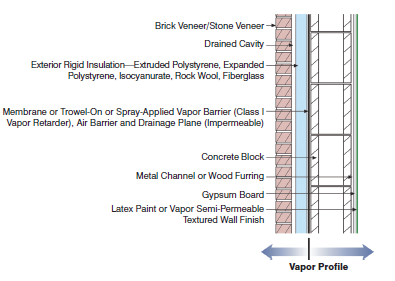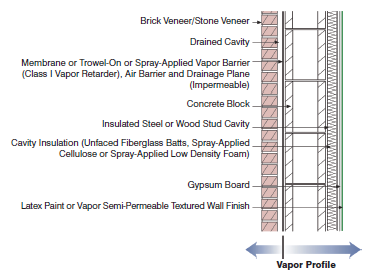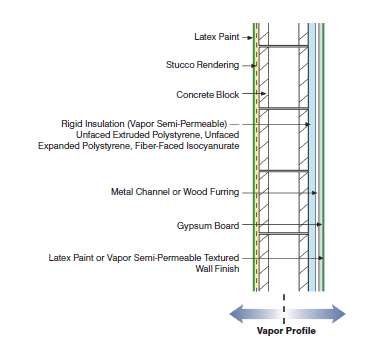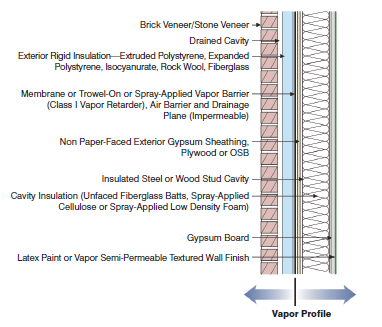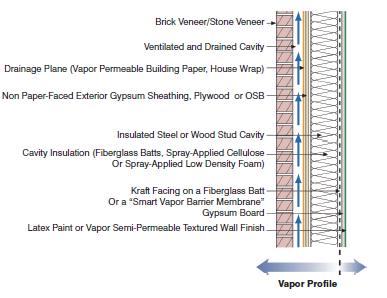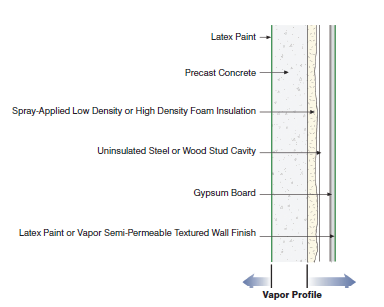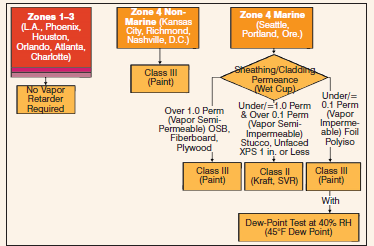Understanding Vapor Barriers
The following article was published in ASHRAE Journal, August 2004. © Copyright 2004 American Society of Heating, Refrigerating and Air- Conditioning Engineers, Inc. It is presented for educational purposes only. This article may not be copied and/or distributed electronically or in paper form without permission of ASHRAE.
By Joseph W. Lstiburek, Ph.D., P.Eng., Member ASHRAE
The function of a vapor barrier is to retard migration of water vapor. Where it is located in an assembly and its permeability is a function of climate, the characteristics of the materials that comprise the assembly and the interior conditions. Vapor barriers are not typically intended to retard migration of air. That is the function of air barriers.
Confusion on the issue of vapor barriers and air barriers is common. The confusion arises because air often holds a great deal of moisture in vapor form. When this air moves from location to location, due to an air pressure difference, the vapor moves with it. This is a type of migration of water vapor. In the strictest sense air barriers are also vapor barriers when they control the transport of moisture- laden air.
An excellent discussion about the differences between vapor barriers and air barriers can be found in Quirrouette.1
Vapor barriers are also a cold climate artifact that have diffused into other climates more from ignorance than need. The history of cold climate vapor barriers itself is a story based more on personalities than physics. Rose2 regales readers of this history. It is frightening that construction practices can be so dramatically influenced by so little research and reassuring that the inherent robustness of most building assemblies has been able to tolerate such foolishness.
So What is The Problem?
Incorrect use of vapor barriers is leading to an increase in moisturerelated problems. Vapor barriers were originally intended to prevent assemblies from getting wet. However, they often prevent assemblies from drying. Vapor barriers installed on the interior of assemblies prevent assemblies from drying inward. This can be a problem in any air-conditioned enclosure, in any below grade space, or when a vapor barrier is also on the exterior. Additionally, this can be a problem where brick is installed over building paper and vapor permeable sheathing.
What Do We Really Want to Do?
Two seemingly simple requirements for building enclosures bedevil engineers and architects almost endlessly:
- Keep water out, and
- Let water out if it gets in.
Water can come in several phases: liquid, solid, vapor and adsorbed. The liquid phase as rain and groundwater has driven everyone crazy for hundreds of years but can be readily understood - drain everything and remember the humble flashing.
The solid phase also drives everyone crazy when we have to shovel it or melt it, but at least most professionals understand the related building problems (ice damming, frost heave, freezethaw damage).
However, the vapor phase is in a class of craziness all by itself. We will conveniently ignore the adsorbed phase and leave it for someone else to deal with. Note that adsorbed water is different than absorbed water.3
The fundamental principle of control of water in the liquid form is to drain it out if it gets in - and let us make it perfectly clear - it will get in if you build where it rains or if you place your building in the ground where there is water in the ground. This is easy to understand, logical, with a long historical basis.
The fundamental principle of water control in the solid form is to not let it become solid. And, if it does, give it space. Or, if it is solid, do not let it become liquid. If it does become liquid, drain it away before it can become solid again. This is a little more difficult to understand, but logical and based on solid research. Examples of this principle include the use of air entrained concrete to control freeze-thaw damage and the use of attic venting to provide cold roof decks to control ice damming
The fundamental principle of water control in the vapor form is to keep it out and to let it out if it gets in. Simple, right? No chance. It becomes complicated because sometimes the best strategies to keep water vapor out also trap water vapor in. This can be a real problem if the assemblies start out wet because of rain or the use of wet materials
It becomes even more complicated because of climate. In general, water vapor moves from the warm side of building assemblies to the cold side. This is simple to understand, except we have trouble deciding what side of a wall is the cold or warm side. Logically, this means we need different strategies for different climates. We also must take into account differences between summer and winter.
Finally, complications arise when materials can store water. This can be both good and bad. A cladding system such as a brick veneer can act as a reservoir after a rainstorm and significantly complicate wall design. Alternatively, wood framing or masonry can act as a hygric buffer absorbing water and lessening moisture shocks.
What is required is to define vapor control measures on a more regional climatic basis and to define the vapor control measures more precisely.
Part of the problem is that we struggle with names and terms. We have vapor retarders, vapor barriers, vapor permeable, vapor impermeable, etc. What do these terms mean? It depends on whom you ask and whether they are selling something, or arguing with a building official. In an attempt to clear up some of the confusion, the following definitions are proposed:
| Vapor Retarder*: | The element that is designed and installed in an assembly to retard the movement of water by vapor diffusion. |
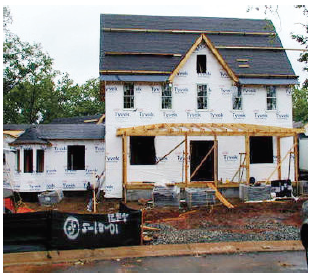
| 'Incorrect use of vapor barriers is leading to an increase in moisture-related problems.' |
The unit of measurement typically used in characterizing the water vapor permeance of materials is the “perm.” It is further proposed here that there should be several classes of vapor retarders. (This is nothing new. It is an extension and modification of the Canadian General Standards Board approach that specifies Type I and Type II vapor retarders. The numbers here are a little different, however.).These classes are:
| Class I | 0.1 perm or less |
| Class II | 1.0 perm or less and greater than 0.1 perm |
| Class III | 10 perm or less and greater than 1.0 perm |
Test procedure for vapor retarders: ASTM E-96 Test Method A (the desiccant method or dry cup method)
Finally, a vapor barrier is defined as:
Vapor Barrier: A Class I vapor retarder.
The current International Building Code (and its derivative codes) defines a vapor retarder as 1.0 perm or less (using the same test procedure). In other words, the current code definition of a vapor retarder is equivalent to the definition of a Class II vapor retarder proposed by the author.
Continuing in the spirit of finally defining terms that are tossed around in the enclosure business, it is also proposed that materials be separated into four general classes based on their permeance (again nothing new, this is an extension of the discussion in a previous ASHRAE Journal article4):
| Vapor impermeable: | 0.1 perm or less |
| Vapor semi-impermeable: | 1.0 perm or less and greater than 0.1 perm |
| Vapor semi-permeable: | 10 perms or less and greater than 1.0 perm |
| Vapor permeable: | greater than 10 perms |
Recommendations for Building Enclosures
The following building assembly recommendations are climatically based (see sidebar, "Hygrothermal Regions") and are sensitive to cladding type (brick or stone veneer, stucco) and structure (concrete block, steel or wood frame, precast concrete).
The recommendations apply to residential, business, assembly, educational and mercantile occupancies. The recommendations do not apply to special use enclosures such as spas, pool buildings, museums, hospitals, data processing centers or other engineered enclosures such as factory, storage or utility enclosures.
The recommendations are based on the following principles:
- Avoiding use of vapor barriers where vapor retarders will provide satisfactory performance. Avoiding use of vapor retarders where vapor permeable materials will provide satisfactory performance. (thereby, encouraging drying mechanisms over wetting-prevention mechanisms).
- Avoiding the installation of vapor barriers on both sides of assemblies, i.e., "double vapor barriers," to facilitate assembly drying in at least one direction.
- Avoiding installation of vapor barriers such as polyethylene vapor barriers, foil faced batt insulation and reflective radiant barrier foil insulation on the interior of air-conditioned assemblies (a practice that has been linked with moldy buildings).5
- Avoiding installation of vinyl wall coverings on the inside of air-conditioned assemblies (a practice that has been linked with moldy buildings).6
- Enclosures are ventilated meeting ASHRAE Standards 62.1 or 62.2.
Each of the recommended building assemblies was evaluated using dynamic hygrothermal modeling. The moisture content of building materials that comprise the building assemblies all remained below the equilibrium moisture content the materials as specified in ASHRAE proposed Standard 160P, Design Criteria for Moisture Control in Buildings, under this evaluation approach. Interior air conditions and exterior air conditions as specified by 160P were used. WUFI was used as the modeling program.7
More significantly, each of the recommended building assemblies have been found by the author to provide satisfactory performance under the limitations noted. Satisfactory performance is defined as no moisture problems reported or observed during at least a 10-year period. The only exceptions relate to the assemblies containing low density spray applied foams. The author has only been familiar with their use in assemblies less than five years old.
Hygrothermal Regions
Subarctic and Arctic
A subarctic and arctic climate is defined as a region with approximately 12,600 heating degree days (65oF basis) (7,000 heating degree days [18oC basis]) or greater.
Very Cold
A very cold climate is defined as a region with approximately 9,000 heating degree days or greater (65oF basis) (5,000 heating degree days [18oC basis]) or greater and less than 12,600 heating degree days (65oF basis) (7,000 heating degree days [18oC basis]).
Cold
A cold climate is defined as a region with approximately 5,400 heating degree days (65oF basis) (3,000 heating degree days [18oC basis]) or greater and less than approximately 9,000 heating degree days (65oF basis) (5,000 heating degree days [18oC basis]).
Mixed-Humid
A mixed-humid and warm-humid climate is defined as a region that receives more than 20 inches (50 cm) of annual precipitation with approximately 4,500 cooling degree days (50oF basis) (2,500 cooling degree days [10oC basis]) or greater and less than approximately 6,300 cooling degree days (50oF basis) (3,500 cooling degree days [10oC basis]) and less than approximately 5,400 heating degree days (65oF basis) (3,000 heating degree days [18oC basis]) and where the average monthly outdoor temperature drops below 45oF (7oC) during the winter months.
Marine
A marine climate is defined as a region where all of the following occur:
- A mean temperature of the coldest month between 27oF (-3oC) and 65oF (18oC);
- A mean temperature of the warmest month below 72oF (18oC);
- At least four months with mean temperatures over 50oF (10oC); and
- A dry season in the summer, the month with the heaviest precipitation in the cold season has at least three times as much precipitation as the month with the least precipitation.
Hot-Humid
A hot-humid climate is defined as a region that receives more than 20 in. (50 cm) of annual precipitation with approximately 6,300 cooling degree days (50oF basis) [3,500 cooling degree days (10oC basis)] or greater and where the monthly average outdoor temperature remains above 45oF (7oC) throughout the year.
This definition characterizes a region that is similar to the ASHRAE definition of hot-humid climates where one or both of the following occur:
- A 67oF (19.5oC) or higher wet-bulb temperature for 3,000 or more hours during the warmest six consecutive months of the year; or
- A 73oF (23oC) or higher wet-bulb temperature for 1,500 or more hours during the warmest six consecutive months of the year.

Hot-Dry, Warm-Dry and Mixed-Dry
A hot-dry climate is defined as region that receives less than 20 in. (50 cm) of annual precipitation with approximately 6,300 cooling degree days (50oF basis) [3,500 cooling degree days (10oC basis)] or greater and where the monthly average outdoor temperature remains above 45oF (7oC) throughout the year.
A warm-dry and mixed-dry climate is defined as a region that receives less than 20 in. (50 cm) of annual precipitation with approximately 4,500 cooling degree days (50oF basis) [2,500 cooling degree day (10oC basis)] or greater and less than approximately 6,300 cooling degree days (50oF basis) [3,500 cooling degree days (10oC basis)] and less than approximately 5,400 heating degree days (65oF basis) [3,000 heating degree days (18oC basis)] and where the average monthly outdoor temperature drops below 45oF (7oC) during the winter months.
References
- Quirouette, R.L. 1985. The Difference Between a Vapor Barrier and an Air Barrier. Building Practice Note 54, Division of Building Research, National Research Council of Canada, ISSN 0701-5216, Ottawa, Ontario.
- Rose, W. 1997. "Moisture control in the modern building envelope: the history of the vapor barrier in the U.S. - 1923 to 1952." APT XXVIII(4).
- Kumaran, M.K., G.P. Mitalas, and M.T. Bomberg. 1994. "Fundamentals of transport and storage of moisture in building materials and components." Moisture Control in Buildings, ASTM Manual Series: MNL 18, ASTM Publication Code (PCN) 28-018094-10, Philadelphia.
- Lstiburek, J.W. 2002. "Moisture control for buildings." ASHRAE Journal 44(2):36-41.
- Lstiburek, J.W. 2002. "Investigating diagnosing moisture problems." ASHRAE Journal 44(12):36-41.
- Lstiburek, J.W. 1993. "Humidity Control in the Humid South," Workshop Proceedings-Bugs, Mold & Rot II, BETEC, Washington.
- Kunzel, H.M. 1999. WUFI: PC Program for Calculating the Coupled Heat and Moisture Transfer in Building Components; Fraunhofer Institute for Building Physics, Holzkirchen, Germany, 1999.
Proposed Building Code
Requirements For Vapor Retarders

Figure 1: Department of Energy's proposed climate zone map.
The proposed building code requirements are based on a combination of field experience and laboratory testing. The requirements were also evaluated using dynamic hygrothermal modeling. The modeling program used was WUFI.1 Under the modeling evaluation, the moisture content of building materials that comprise the building assemblies evaluated all remained below the equilibrium moisture content of the materials as specified in ASHRAE proposed Standard 160P, Design Criteria for Moisture Control in Buildings. Interior air conditions and exterior air conditions as specified by 160P were used. Enclosures are ventilated to meet ASHRAE Standards 62.1 or 62.2.
The climate zones referenced are the U.S. Department of Energy climate zones as proposed for adoption in the 2006 International Residential Code (IRC) and International Energy Conservation Code (IECC). Their development is the subject of two ASHRAE papers.2,3 An accompanying map defines the climate zones.
Note that vapor retarders are defined and classed using ASTM E- 96 Test Method A (the desiccant method or dry cup method) consistent with the current code language. However, exterior sheathing/cladding assemblies are defined and classed using Test Method B (the "wet cup" method) to take advantage of the ability of some sheathings to "breathe" as they are exposed to high relative humidities.
| Zone 4 (marine) | 40% RH at 70oF | Dew Point 45oF |
| Zone 5 | 30% RH at 70oF | Dew Point 37oF |
| Zone 6 | 25% RH at 70oF | Dew Point 32oF |
| Zone 7 | 10% RH at 70oF | Dew Point 28oF |
Table 1: Design conditions for steady-state design procedure (wall and floor assemblies).
| Zone 5 | 35% RH at 70oF | Dew Point 39oF |
| Zone 6 | 30% RH at 70oF | Dew Point 37oF |
| Zone 7 | 25% RH at 70oF | Dew Point 32oF |
Table 1: Design conditions for steady-state design procedure (wall and floor assemblies).
1. Zones 1, 2, and 3 do not require any class of vapor retarder on the interior surface of insulation in insulated assemblies (this recommendation has already been accepted by the code committee at the code hearings in Nashville, September 2003 and Kansas City, May 2004).
2. Zone 4 (not marine) requires a Class III (or lower) vapor retarder on the interior surface of insulation in insulated wall and floor assemblies.
3. Zone 4 (marine) requires a Class III (or lower) vapor retarder on the interior surface of insulation in insulated wall and floor assemblies where the permeance of the exterior sheathing/cladding assembly is greater than 1.0 perm as tested by Test Method B (the "wet cup" method of ASTM E-96).
4. Zone 4 (marine) requires a Class II (or lower) vapor retarder on the interior surface of insulation in insulated wall and floor assemblies where the permeance of the exterior sheathing/cladding assembly is less than or equal to 1.0 perm and greater than 0.1 perm as tested by Test Method B (the "wet cup" method) of ASTM E-96).
5. Zone 4 (marine) requires a Class III (or lower) vapor retarder on the interior surface of insulation in insulated wall and floor assemblies where the permeance of the exterior sheathing is 0.1 perm or less as tested by Test Method B (the "wet cup" method) of ASTM E-96) and the interior surface of the exterior sheathing shall be maintained above the dew-point temperature of the interior air. Under this design approach assume steady-state heat transfer, interior air at a temperature of 70oF (21oC), at a relative humidity specified in Table 1 and exterior air at a temperature that is equal to the average outdoor temperature for the location during the coldest three months of the year (e.g., December, January and February).
6. Zone 5 requires a Class III (or lower) vapor retarder on the interior surface of insulation in insulated wall and floor assemblies where the permeance of the exterior sheathing is greater than 1.0 perm as tested by Test Method B (the "wet cup" method) of ASTM E-96.
7. Zones 6 and 7 require a Class II (or lower) vapor retarder on the interior surface of insulation in insulated wall and floor assemblies where the permeance of the exterior sheathing is greater than 1.0 perm as tested by Test Method B (the "wet cup" method) of ASTM E-96.
8. Zones 5, 6 and 7 require a Class II (or lower) vapor retarder on the interior surface of insulation in insulated wall and floor assemblies where the permeance of the exterior sheathing/cladding assembly is less than or equal to 1.0 perm and greater than 0.1 perm as tested by Test Method B (the "wet cup" method) of ASTM E-96.
9. Zones 5, 6 and 7 require a Class II (or lower) vapor retarder on the interior surface of insulation in insulated wall and floor assemblies, where the permeance of the exterior sheathing is 0.1 perm or less as tested by Test Method B (the "wet cup" method) of ASTM E-96 and the interior surface of the exterior sheathing shall be maintained above the dew-point temperature of the interior air. Under this design approach, assume steady-state heat transfer, interior air at a temperature of 70oF (21oC), at a relative humidity specified in Table 1, and exterior air at a temperature that is equal to the average outdoor temperature for the location during the coldest three months of the year (e.g., December, January and February).
Table 3 (left): Summary of recommendations for vapor retarders on the interior of wall assemblies. Figure 2 (right): Vapor barrier flow chart, Zones 1-4.
